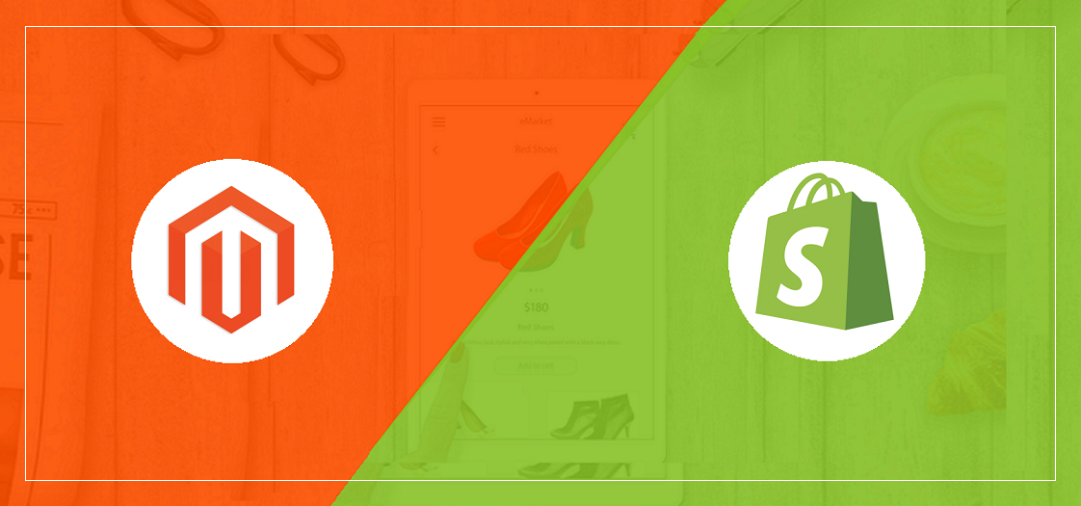Choosing an ideal eCommerce platform is deciding the fate of your business, the future and the potential success. You just can’t afford to make a “leap of faith” – you need to be well aware and informed about the pros and cons of the available platforms – without falling for any kind of misleading information. Failing to choose wisely might hamper future growth, the success of your online store and leave you empty-handed.
Now, to ensure maximum ROI from your eCommerce development project, you need to power your store with the best platform. The real deal, however, is narrowing down your scope to the two ultimate solutions that have long dominated the industry – Magento and Shopify. None seems inferior to the other, yet one proves to be more powerful.
The most brewed misconception about these two is the tendency of being considered similar. But, the truth is that even though they both serve the same purpose, they are drastically different in almost every aspect. This includes their core structure, payment options, handle extensions, add-ons, performance, speed and other functionalities and capabilities. Before moving to the core differences between the two, it is important to understand the similarities that make them equally attractive to merchants around the globe.
The Common Ground
Both, Magento and Shopify, offer a wide range of features and functionalities that facilitate seamless online business. They give you a well-constructed user interface that is both powerful and easy to use. Furthermore, when it comes to scaling your eCommerce store, both have the capability to facilitate growth and expansion (though they follow very different paths in this regard).
All that’s now left is which of the two would be the best for your business! Let’s figure it out with the dissimilarities.
Where They Part Ways
Inventory Management
Each platform offers its personalized take on inventory management. Both cater to your needs – you just need to pick the one that will help you do more in less time. Among standard features, you can find inventory importing, categorizing and filtering, as well as product and pricing variations.
Shopify isn’t made for large online stores – it brings a simple and straightforward interface where you can take control of your inventory. Several capable extensions bring advanced features like promotional flash sales, discounts for registered users, and more.
Magento comes with a basic inventory upload out-of-the-box, just like Shopify. However, this platform stands out when it comes to advanced features. For example, it offers different variation possibilities including product sizes, colors and a number of third-party services for integrating a broader distribution network. This might require more work but would surely pay off in the long term.
Control and Customization
Hosting and control are one of the most prominent differences between Magento vs Shopify.
Magento is self-hosted, meaning you have full control over your choice of servers and hosting. Combined with its open source nature, it provides you endless customization possibilities along with complete control over the look and feel of your store. Furthermore, you can easily update and customize the store at your discretion without being restricted to a certain level of technology or integrations.
Shopify, on the other hand, is a hosted solution and doesn’t require a high level of development expertise. While it saves you from the troubles of configuration and hosting hassles, you are unable to access the source code, which limits your options of store level customization.
Payment Gateway Options
When it comes to online shopping and the end user, payment gateway option is one of the most crucial things.
Shopify has a major edge here, with support for over 70 payment gateways while Magento is relatively at a disadvantage with support for a far lower number of gateways. However, more gateways can be easily added to Magento store via third-party add-ons.
The main issue that users generally face with Shopify is that it kind of forces you to go with its built-in payment gateway. Though its gateway has no transaction fees, they certainly charge for third-party gateways.
Apps and Add-ons
Shopify offers approximately 100 apps and add-ons that assist in enhancing and expanding the functionality of your online store in various ways. The Shopify App store is constantly growing, with apps for loyalty programs, accounting, and email marketing.
On the other hand, Magento comes with a whopping 5000+ apps and add-ons. This is primarily because of the large, open source, community-driven nature of the platform.
Multi-lingual Capabilities
Shopify does not offer full multi-lingual capabilities directly. In order to create fully multi-lingual stores, it offers third-party/paid apps. The other way to do it is by custom coding your theme so that it has multilingual capabilities. However, you will have to to find an expert to complete the task.
Magento saves you from the hassles by offering built-in multi-lingual support.
The Winner
Well, the battle is very close and fierce!
It is completely dependent on your business size, type and goals. Each platform comes with its own set of functionalities and potential- you have to hit the right note.
However, the discussion favours Magento to a certain extent. While allowing complete control over your customer experience, Magento enables merchants to handle the complexities of B2B commerce in an unsurpassed manner.






